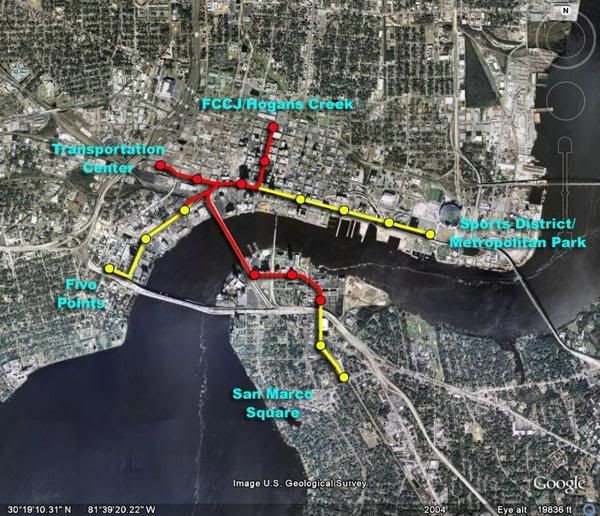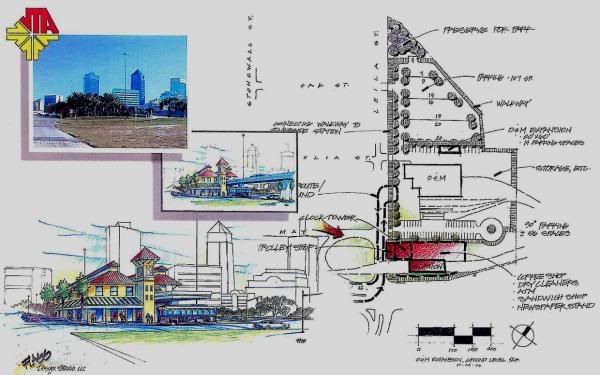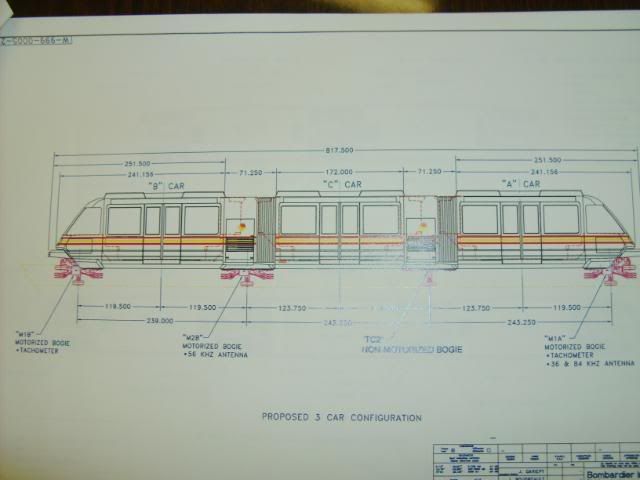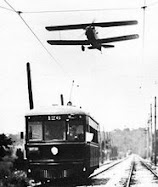 What did $184 Million buy? All of the red lines. But it goes much deeper then that, it bought access to all of the yellow lines too. It also bought and paid for a maintenance facility for a large railroad, Positive Train Control, a complete signaling system, full automation, full surveillance, instant communications and automatic dispatching. It paid for a monorail railroad yard, the rights to the center cars of this design which we own outright. It paid for an impressive soaring bridge with double track over the St. Johns River - no small feat in the swift flowing extreme depths of the twisting narrows downtown. The same spot where a US Navy frigate was tied up last weekend, and before that the research vessel Atlantis. This map just demonstrates some of the lines that are being actively watched, if not planned by JTA.
What did $184 Million buy? All of the red lines. But it goes much deeper then that, it bought access to all of the yellow lines too. It also bought and paid for a maintenance facility for a large railroad, Positive Train Control, a complete signaling system, full automation, full surveillance, instant communications and automatic dispatching. It paid for a monorail railroad yard, the rights to the center cars of this design which we own outright. It paid for an impressive soaring bridge with double track over the St. Johns River - no small feat in the swift flowing extreme depths of the twisting narrows downtown. The same spot where a US Navy frigate was tied up last weekend, and before that the research vessel Atlantis. This map just demonstrates some of the lines that are being actively watched, if not planned by JTA.
Love this photo, it was evening and a rather ferice storm had just past. Everything was fresh and washed the the fall weather in Jacksonville unlike the rest of Florida is seasonal. So while Orlando, Tampa and Miami sweltered in 90 degree heat, we enjoyed one of those evenings of eternal 72 degrees.

Are there any plans to move forward? Oh yes, just blow off the dust and belly up to the bar. This is the inter modal center planned for Brooklyn Park. Brooklyn is a historic neighborhood on a bluff, south of Jacksonville Union Terminal and Mc Coy's Creek. This station would be located between the Skyway rail yard and Riverside Avenue, across the street from the Florida Times-Union Publishing Company.

At the Rainbows end, I caught the 2 car shuttle heading for Riverplace Station just after a thunder storm. Had to climb a wall for this shot which probably caused no small consternation back in the control-monitoring center, but with the help of a very kind homeless man, we cleaned the window inside and out and I got my shot. In celebratory thanks my new friend got his Skyway fares.

Some of that investment went inside the operations center, a center that once inside is jaw dropping impressive, even for a hardened railroader. Here is a cross between NASA's "VAB" or Vehicle Assembly Building and railroad shops of the FEC's Bowden Yard. Great pride shows throughout as the employees all seem on first name basis, jokes flew around the room and yet one could eat off of the polished floor. This shop is so well equipped that the Skyway Train in this picture is under it's own overhead Monorail - one that can move it around the shop. The bright work, painted surfaces, lettering and layout would make a fireman blush.
 What is Positive Train Control? The best way to describe it to the layman would be to say it's running a railroad as if it were a computerized toy train. Here the operator on the left and the monitor - station manager and voice of the Skyway is on the right. There is room for two more positions here as the system grows, and it would be easy to add four new people. A system map in the the upper center, it shows the movement-size-speed-direction-track and signal indication of every train. Around that map are 72 computer camera screens, including aboard every train car. We would never have to buy this building and all of it's treasures again, they are ours to use.
What is Positive Train Control? The best way to describe it to the layman would be to say it's running a railroad as if it were a computerized toy train. Here the operator on the left and the monitor - station manager and voice of the Skyway is on the right. There is room for two more positions here as the system grows, and it would be easy to add four new people. A system map in the the upper center, it shows the movement-size-speed-direction-track and signal indication of every train. Around that map are 72 computer camera screens, including aboard every train car. We would never have to buy this building and all of it's treasures again, they are ours to use.
We mentioned growth, did you know the system could handle 30,000 passengers per hour per direction according to Steve Arrington of JTA. Of course we need the center cars and we could order them in sets of 1, 2 or 4 so our trains could range from 2 - 6 cars long. The gates are also already in place at the stations, we simply need to punch them out, but everything is in readiness.
A SKYWAY CALLED REPULSIVE...
THE JTA Skyway is a monorail in Jacksonville, Florida, in the United States. It is operated by the Jacksonville Transportation Authority. The course of its 2.5-mile dual track includes the Acosta Bridge, spanning the St. Johns River, which divides downtown Jacksonville. Each train is automated by SCADA, can have two to six cars, and travels at up to 35 miles per hour. Fare between any of its eight stations is 50 cents.The idea of a Jacksonville people mover dates back at least to a 1971 report for the Jacksonville Area Planning Board. Work began in 1984, and the first leg opened in 1989. The second phase and third phases, including the river crossing, and conversion to monorail, were completed by November 1, 2000. The total cost of the system $184,000,000, much of it paid through Federal Grants.Old Skyway original route map here:The Skyway has been one of the biggest points of contention in Jacksonville. Many critics say it goes "from nowhere to nowhere", yet it was never finished. Some community activists have suggested that extensions into neighboring communities like Riverside, San Marco, and Springfield would improve the line's usefulness. Further, it has been noted that the Skyway would attract ridership from the proposed (but unbuilt) East Line, which would resolve the issue of Jacksonville's future rail transit system being one of the few in the country that does not serve its local sports district.According to figures from APTA, average weekday ridership in first quarter 2008 was 1,700, about 30% below the previous year's figure.
It's certainly easy to sit back and make light of the Skyway, everyone seems to be guilty at some point. Robert Mann a Transportation Supervisor with Trailways Bus System joined with Jacksonville Journal Editor, the late George Harmon, in launching an all out attack on the Skyway plans as soon as they became public knowledge. The two were promoting a combination Light Rail and Heritage Streetcar system that would have been the first of it's kind in the country. Based on the San Diego experience of the same time period, and our ultimate investment in the Skyway, we could have built 32 miles of rail for the cost of 2.5 Skyway miles.
Even former Mayor Jake Godbold, who pushed the project over the top says we should have never have built it. Perhaps the only thing worse then building any unproved fixed transit system, is half-way building it. In the case of the Skyway it seems the City and the original critics have swapped positions. As the wildly optimistic ridership projections of JTA began to crumble from 50,000 to 30,000, 17,000, 10,000 and finally 7,000 daily riders, to a reality of about 3,000. Then the jokes started and the splashes made by the politicians bailing off this sinking ship could be heard in Washington DC. Indeed the City went into damage control when international press attention was focused on the half built transit system. "A hotel wasn't built", "downturn in the economy," "downtown failed to develop", everyone inside had an excuse. Everyone outside couldn't resist one more swipe at Jacksonville. JTA no longer had a voice and the vultures were already circling. Even the FTA in Washington when speaking about the Skyway claimed they didn't know where Jacksonville was. Today fear paralyses all party's at a time when the worst thing we can do is sit on the Skyway as-is and hope for the best. This is done by a well meaning political machine that doesn't want to appear irresponsible for the stewardship of the City's limited budget. They feel they would appear irresponsible as the media has continued the attack started on the Skyway in 1980. No one has taken pause to consider the fallacy of attacking our only green, fixed, clean, electric, traffic free source of transportation in a world of soaring gasoline prices.
The following is a typical excerpt from the press, though I didn't reprint the entire article, the writer actually ended it with the word on monorail systems, "None of them make a profit." Incredible.
Skyway ridership remains sparse
Passenger count on the downtown rail system has dropped by almost 20 percent in the past two years.
By LARRY HANNAN, The Times-Union
Jake Godbold lobbied for the Skyway when he was Jacksonville mayor. He looks at the elevated rail system today and said his support was misplaced.
"I keep thinking it will catch on, but so far, it hasn't," said Godbold, who was mayor from 1979 to 1987. "We just don't want to give our cars up."
Former Mayor John Delaney, who was critical of the Skyway when he first ran for office, jokes that he has now mellowed to the point he thinks the Skyway can work for Jacksonville.
"For some special events, like the Super Bowl, it's been very nice," said Delaney, who was mayor from 1995 to 2003. "It's also been an asset to downtown development, even if there aren't many people who ride it."
Almost 20 years after the first portion of the Skyway opened in 1989, the 2 1/2-mile downtown rail system remains an underachiever. Ridership has dropped by almost 20 percent in the past two years.
In the first quarter of 2008, the system averaged 1,700 riders a day. That increased to 2,000 a day in the second quarter, which Jacksonville Transportation Authority attributes to more people accepting a fare increase from 35 to 50 cents that occurred in 2007. But for a system that was once expected to attract 38,000 riders a day, an increase to 2,000 riders is still underwhelming.
In fiscal year 2007-08, expenses were $4.5 million for the Skyway and revenue was $407,000. About $1.7 million of those expenses were paid for by a recurring grant awarded by the federal government, and JTA paid the rest at a loss of more than $2 million.
Robert Mann, a retired transportation consultant and a longtime Skyway critic, said the fundamental problem with the Skyway is it doesn't go anywhere. Expanding it so it can go closer to Five Points, Jacksonville Municipal Stadium and San Marco is the way to make the system viable, Mann said.
The Jacksonville Transportation Authority still sees it differently.
The key to increasing ridership isn't in expanding the Skyway, it's in complementing the existing Skyway with other transportation options, said Scot Clem, JTA's strategic planning director. Those options include a new bus rapid transit system and efforts to bring commuter rail from the suburbs to the city. Major expansions to the Skyway, Clem said, are just too expensive.
Minor expansions
JTA is considering minor expansions to Riverside and Leila streets and might also try to extend the Skyway from its current endpoint at Kings Avenue to Atlantic Boulevard.
JTA is also studying the feasibility of commuter rail. Executive Director Michael Blaylock has previously expressed optimism that people living in the suburbs would be willing to take a light rail system into the downtown area.
Light rail usually means streetcars or trams. Some light rail cars run on streets, while others require tracks to be built. Although the JTA has studied similar systems in Raleigh and Charlotte, N.C., it is unclear how much a commuter rail system would cost here. It is also unclear if local officials possess the funds or the political will to build a new transportation network.
The city is also working toward a new rapid transit system that will put more buses on the road, Clem said.
Steve Arrington, director of engineering for JTA, said there were a lot of plans for downtown development in the late '80s and early '90s, when the city built what was then called the Automated Skyway Express. Most of that development didn't happen.
The development that has happened in the last few years was not constructed with the Skyway in mind. For example, new parking garages went up near or within some of the new developments, which discouraged people from using the Skyway, Arrington said.
Feds paid more than half
The $184 million project opened in different phases between 1989 and 2000. More than half the money came from the federal government, without whose help Godbold and Delaney agreed the system would not have been built.
Godbold said the Chamber of Commerce was convinced the Skyway was one of the keys to redeveloping the downtown, and when the gas crisis hit in the late '70s, the Skyway sounded like a solution.
At the same time, the federal government also contributed money to Miami's 4.4-mile Metromover and Detroit's 2.9-mile People Mover. All three projects were an attempt to determine whether fully automated downtown rail systems would stimulate economic development and cost less than running downtown bus services.
Clem said there are differences between the systems. Miami's Metromover is free; you have to pay 50 cents to ride the Skyway. The Metromover also connects to the 21-mile Metrorail system that goes throughout the Miami area.
The People Mover in Detroit, which costs 50 cents, connects directly to government buildings in the downtown area, Clem said.
All three projects have one thing in common, though: Ridership has been disappointing, and none of them turns a profit.
TOO EXPENSIVE TO TAKE SERIOUSLY?
The $184 million project opened in different phases between 1989 and 2000. More than half the money came from the federal government, without whose help Godbold and Delaney agreed the system would not have been built.
Godbold said the Chamber of Commerce was convinced the Skyway was one of the keys to redeveloping the downtown, and when the gas crisis hit in the late '70s, the Skyway sounded like a solution.
At the same time, the federal government also contributed money to Miami's 4.4-mile Metromover and Detroit's 2.9-mile People Mover. All three projects were an attempt to determine whether fully automated downtown rail systems would stimulate economic development and cost less than running downtown bus services.
Clem said there are differences between the systems. Miami's Metromover is free; you have to pay 50 cents to ride the Skyway. The Metromover also connects to the 21-mile Metrorail system that goes throughout the Miami area.
The People Mover in Detroit, which costs 50 cents, connects directly to government buildings in the downtown area, Clem said.
All three projects have one thing in common, though: Ridership has been disappointing, and none of them turns a profit.
TOO EXPENSIVE TO TAKE SERIOUSLY?
Was the Skyway too expensive? Certainly, for the actual route miles that we have running, the cost per mile was one of the most expensive in history. But that isn't the Skyways fault, most of that was system support, maintenance base, bridge and computer-signal systems. Wouldn't expansion, even modest expansion, just continue the hemorrhage of red ink? No! In fact every inch of expansion would bring down the cost per mile of the entire system.
Please understand the real expense in the original building and the conversion to monorail accomplished two major goals. The facilities and signals, computers and shops, are State-of-the-Art, expansion would take place with little to no more investment, they could handle the needs of a system 20 - 40 or 60 miles long. The money quite simply was spent up front to give us the ability to expand quickly and cheaply in any direction. The conversion to monorail from the original system gave us untold flexibility and off-the-shelf purchasing power. The final big piece was the St. Johns River crossing on the new Acosta Bridge, certainly not a cheap undertaking even if we would have built a bridge for pogo sticks. Perhaps the blue neon chaser lights were an added option, but hey, this is Jacksonville, can you think of a bridge that isn't distinct?
Working with City Council Woman Glorious Johnson, has been a joy, she is one of the few, proud visionaries that see past the gloom and doomsayers. Speaking with many suppliers of monorail systems they can't understand why we couldn't expand for under $15 Million per mile. So we have this fantastic Skyway, a wonderful super system that frankly the city hasn't caught up with. Every mile we add for $10 or even $20 Million will bring down the overall cost-per-mile of the finished system, and raise the passenger count. In fact, doing the math, demonstrates that the Skyway at 10 miles in length, would come down in price - allowing for the $184 Million already spent + the $300 Million in new expansion to about $28 Million per mile. The Quick-Way BUS RAPID TRANSIT that JTA has in it's current sights will cost about $26 Million a mile. In short we could build true Monorail for the cost of Quick-Way BRT. Using the same numbers, if the Skyway ever reached the proposed 26 mile length of the planned BRT system, by then it's cost per mile would drop to 1/2 that of the "super bus system".
Monorail for half the price of bus.
But City Hall, DOT and perhaps even JTA have cold feet. Like an angler that went over the top for the most expensive rod and reel in the world. He now has the tools to bring home the really big fish, but he spent so much on the basics, that now his wife won't let him buy any line... "You've already broke the bank, I'll be darned if I'm going to let you add one inch of new line, or invest one more dollar, just go out there and figure out how to make it work just like it is!"
We already have everything we need for a first class Skyway system, many miles worth if we so desire. Our Skyway with it's tight curves and grades was never intended as a long distance carrier, but it could be the master of "up town" in Jacksonville. A matrix of central Skyway trunk lines, Streetcar-LRT suburban lines, Commuter Rail from the surrounding metroplex, bus - BRT Lite - electric trolley bus feeders and shuttles, and our water bus, all layered for choice and connectivity, would be unbeatable. Bay Street at Hogans Creek could even become the only station the world where Monorail meets bus, water bus, heritage streetcars, and a proposed Sky Cable. Certainly the Skyway itself isn't going to catch many "fish" without some line. All the PCT-Trolleys in the world feeding it are not going to amount to a drop in the sea. So expand it now, Riverside, The Stadium, San Marco, St. Vincents, Shands via Davis and the new Court House, Memorial Hospital, Ed Waters, JU, Jones, JUST DO IT. Add in a few miles of streetcar, commuter rail to the outlaying areas, and BRT-LITE (known as: "BRT-Light-rail-lite") or electric BRT-L, Trolley buses to Mandarin, Beaches, and Northwest side, and we would join the worlds big league cities with a transit system second to none.
=============================================
Terms Defined:
BRT Quick-Way: is a bus system using grade separateded, sometimes elevated buswaysand exclusive bus lanes - it has been shown to cost as much or more then Light Rail.
BRT Lite: is generally called "Light rail - lite" is a bus system using some of the Quick-Way features at congestion points, otherwise it uses HOV lanes and signal priority - it's cost is about equal with commuter rail.
PCT-Trolleys: A local term introduced by this blog and it's author to describe the faux trolleys that are built on chassies used to build Potato-Chip-Trucks, Thus the name "Potato-Chip-Truck-Thinks-It's-A-Trolley" or JTA own accronym for this phenomonon which is simply the "PCT Trolley Fleet".
===================================================
Special Thanks to my friend and fellow activist Mr. Ennis Davis, Urban Planner, and the MetroJacksonville.com team, see: http://www.metrojacksonville.com/ for more storys, photos and information.


























Lovely write up. As a daily commuter to downtown Jacksonville, I would find it amazing to see JTA develop Light Rail networks in the future. The idea of completing the Skyway seems right. It would be a bigger shame to not develop the system to what it was originally designed to do; rather than letting it sit in the dark. I’m surprised to not find any campaigning efforts for policy changes. Do they exist?
ReplyDelete-MP